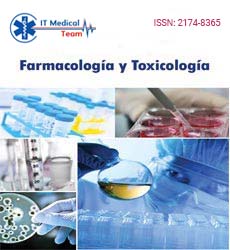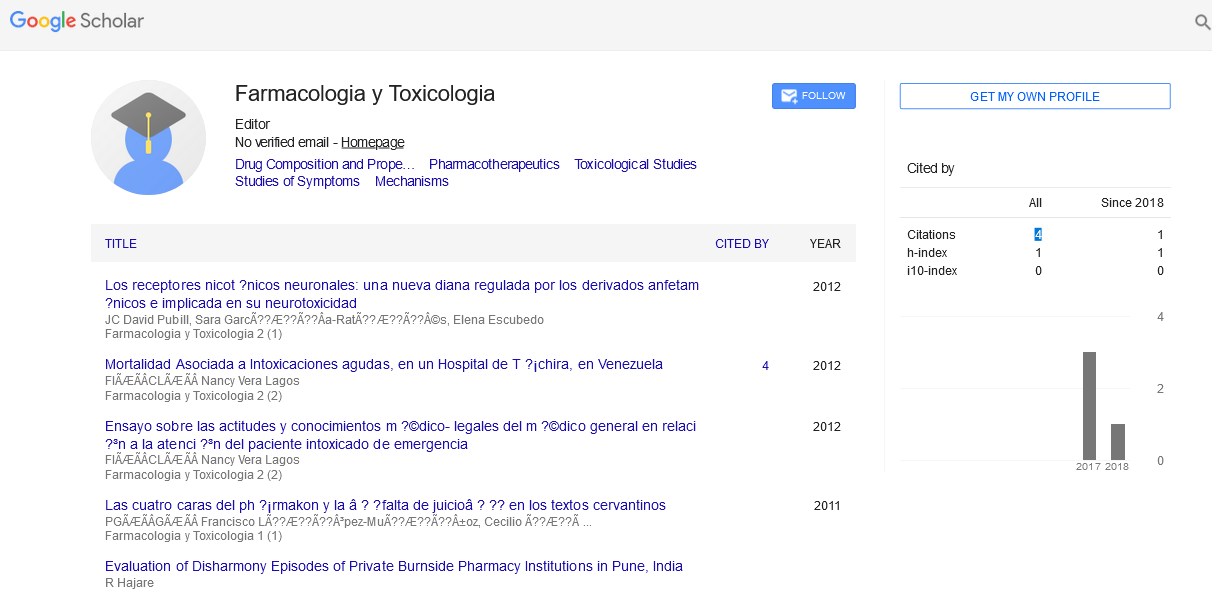Commentary Article - (2023) Volume 13, Issue 2
Toxicological Studies: Evaluating the Potential Harmful Effects of Chemicals and Ensuring Safety
Hashimoto Kebi*
Department of Clinical Pharmacy, School of Pharmacy, University of California San Francisco, San Francisco, CA 94143, USA
*Correspondence:
Hashimoto Kebi, Department of Clinical Pharmacy, School of Pharmacy, University of California San Francisco, San Francisco, CA 94143,
USA,
Email:
Received: 03-Apr-2023, Manuscript No. ipft-23-13757;
Editor assigned: 05-Apr-2023, Pre QC No. P-23-13757;
Reviewed: 19-Apr-2023, QC No. Q-23-13757;
Revised: 21-Apr-2023, Manuscript No. R-23-13757;
Published:
29-Apr-2023
Abstract
Toxicological studies are necessary for evaluating the potential harmful effects of chemicals and other substances on living organisms. These studies encompass a range of methods and techniques, including in vitro and in vivo studies, acute and chronic evaluations, and risk assessments. The information generated from these studies is essential for regulatory agencies, industry, and consumers to ensure the safety of products and the environment. This short communication provides a brief overview of the key elements of toxicological studies, including toxicity testing, risk assessment, and toxicity data.
Keywords
Toxicology; Toxicity testing; Risk assessment; Toxicity data; Regulatory agencies; Industry; Living organisms; Acute and chronic evaluations; Bioaccumulation; Persistence
INTRODUCTION
Toxicological studies are essential in assessing the potential
harmful effects of chemicals and other substances on living
organisms. These studies provide valuable information for
regulatory agencies, industry, and consumers to ensure
the safety of products and the environment. In this short
communication, we provide a brief overview of the key
elements of toxicological studies [1, 2].
DISCUSSION
Addiction to drugs is a major issue in our society. Even
though many drugs are used for legitimate medical
purposes, abuse of some of them can be extremely
dangerous. We'll look at some drugs that can be harmful
to humans in this article. Toxicity testing is the process
of evaluating the potential adverse effects of a substance.
These tests are conducted using a range of methods and
techniques, including in vitro and in vivo studies. In vitro
studies use cell culture or tissue models, while in vivo studies
use living organisms, such as animals or humans. Toxicity
testing is typically divided into acute and chronic studies.
Acute studies evaluate the effects of a substance over a short
period, while chronic studies evaluate the effects of longterm
exposure [3, 4].
Risk assessment
Risk assessment is the process of evaluating the potential
risks associated with exposure to a substance. This process
considers factors such as exposure routes, dose-response
relationships, and the potential for bioaccumulation and
persistence in the environment. Regulatory agencies use
risk assessment to establish guidelines and regulations for
the use of chemicals and other substances. Industry also
uses risk assessment to develop safer products and processes
[5, 6].
Toxicity data
Toxicity data is the information generated from toxicity
testing and risk assessment. This data is used to determine
safe exposure limits for substances and to develop
regulations and guidelines. Toxicity data is also used by
industry to develop safer products and processes, as well as
to provide information to consumers about the potential
risks associated with using products containing certain
substances [7, 8].
CONCLUSION
In conclusion, chemicals use is a complicated issue with benefits and drawbacks. While medications can be a viable
therapy for ailments, they can likewise make negative
side impacts, be habit-forming, and bring about reliance
or go too far. Accordingly, it is vital to think about both
the advantages and dangers of medication consumption
prior to beginning or halting any drug cautiously [9]. The
treatment of medical conditions is one of the main benefits
of using drugs. For many people, prescription drugs can
help manage or cure diseases, alleviate pain, and enhance
quality of life. Antibiotics, for instance, can treat bacterial
infections and lower blood pressure, both of which can
lower the risk of heart disease. Antidepressants and anxiety
medications, for example, have been shown to improve
mental health and alleviate mental illness symptoms.
Preventative care is yet another advantage of taking drugs.
Some medications, like cholesterol-lowering medications
or vaccines, can be taken to prevent illnesses or conditions.
This can be especially important for people who have a
family history of certain diseases or conditions and risk
factors like obesity, high cholesterol, or high blood pressure
[10].
Toxicological studies are essential for ensuring the safety
of chemicals and other substances. These studies provide
valuable information for regulatory agencies, industry,
and consumers to make informed decisions about the
use of these substances. By evaluating the potential risks
associated with exposure to substances, we can ensure that
products and processes are safe for human health and the
environment.
This can be especially challenging for people who don't
have health insurance or who don't have a lot of money.
Another potential danger that comes with taking drugs is
drug interactions. Negative side effects or decreased drug
efficacy may result from taking multiple medications at once. Consequently, it is critical to illuminate medical
services suppliers pretty much all prescriptions and
enhancements being taken, including non-prescription
medications. An overdose, which can be life-threatening
or even fatal, can occur when a person takes in too much
of a drug. Accidental ingestion, deliberate misuse, and
drug interactions are all potential causes of overdose. As
a result, it's critical to keep medications safe and never
take more than what's prescribed. Last but not least,
people who use drugs for a long time may develop physical
dependence, making it difficult for them to stop without
experiencing withdrawal symptoms. People with mental
health conditions and chronic pain who rely on medication
to manage their symptoms may find this particularly
challenging.
Chemical use is a complicated issue with benefits and
drawbacks. Before taking any medication, it is essential
to carefully consider the potential risks and side effects,
despite the fact that drugs can be an effective treatment
for medical conditions. Additionally, it is essential to
always adhere to the doses that have been prescribed and
to consult a healthcare professional prior to beginning or
stopping any medication. By understanding the benefits
and inconveniences of medication consumption, we can
come to informed conclusions about our medical care and
work with medical services suppliers to foster a protected
and viable therapy plan.
ACKNOWLEDGMENT
None
CONFLICT OF INTEREST
No conflict of interest to declare about this work.
REFERENCES
- Wall F, Mariano AN, Jones AP, et al. Rare earth minerals in carbonatites: a discussion centred on the Kangankunde carbonatite, Malawi: Rare Earth Minerals: Chemistry, Origin and Ore Deposits Mineralogical Society Series 7 Chapman and Hall. Sci Adv.2005; 56(1):193-225.
Google Scholar, Crossref
- Deans T, Powell JL. Trace elements and strontium isotopes in carbonatites, fluorites and limestones from India and Pakistan. Nature.1968; 218(5): 750-752.
Indexed at, Google Scholar, Crossref
- Gruau G, Petibon C, Viladkar SG, et al. Extreme isotopic signatures in carbonatites from Newania Rajasthan. Terra Abstracts.1995; 7(2): 336-338.
Indexed at, Google Scholar, Crossref
- Schleicher H, Todt W, Viladkar SG. Pb/Pb age determinations on Newania and Sevathur carbonatites of India: evidence for multi-stage histories. Chemical Geology.1997; 140(6): 261-273.
Indexed at, Google Scholar, Crossref
- Ray JS, Pandey K, Bhutani R, et al. Age and geochemistry of the Newania dolomite carbonatites, India: Implications for the source of primary carbonatite magma. Contrib to Mineral Petrol. 2013; 166(4): 1613-1632.
Indexed at, Google Scholar, Crossref
- Le Bas MJ. Diversification of carbonatites; In: Bell, K (Ed), Carbonatites. Genesis and evolution Unwin Hyman.1986; 5(1): 428-447.
Google Scholar, Crossref
- Eggler DH. Composition of the partial melt of carbonated peridotite in the system Ca0-Mg0-Si02-C02. Carnegie Inst Wash Year.1976; 75(6): 623-626.
Indexed at, Google Scholar, Crossref
- Wyllie PJ, Huang WL. Influence of mantle CO2 in the generation of carbonatites and kimberlites. Nature. 1995; 257(2): 297-299.
Indexed at, Google Scholar, Crossref
- Wendlandt RF, Harrison WJ. Rare earth element partitioning between immiscible carbonate and silicate liquids and CO2 vapor: Results and implications for the formation of light rare earth enriched rock. Contrib to Mineral Petrol.1979; 29(8): 242-254.
Indexed at, Google Scholar, Crossref
- Lee WJ, Wyllie PJ. Petrogenesis of carbonatite magmas from mantle to crust, constrained by the system CaO-(MgO+ FeO*)-(Na2O + K2O)-(Si2O + Al2O3 + TiO2)-CO2. Journal of Petrology.1968; 39(3): 495-517.
Indexed at, Google Scholar, Crossref





